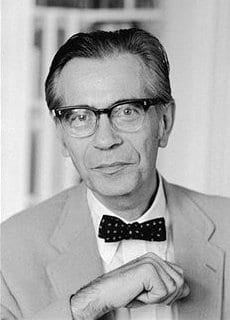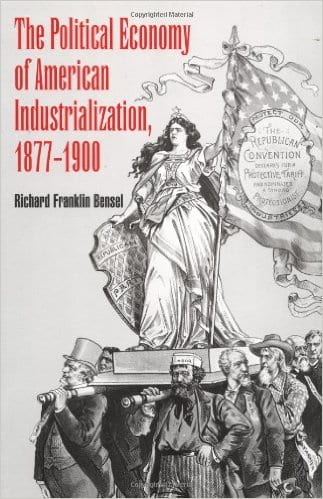By Daniel London
Two different kinds of literature sit uneasily next to each other on bookshelves. One group falls under the rubric of American political development (APD) scholarship, an innovative subfield of Political Science. The other books are more generally works of intellectual history and ideas, dedicated to understanding the development, articulation, and life of concepts. Looking to how APD scholars have theorized the role of ideas in their methodology, how can practitioners of both approaches better speak to and inform one another’s research?
Such cross-fertilization saw their last great period of flourishing in the 1950s as historians enlisted theories from both the social sciences and the humanities to explain American politics. Richard Hofstadter exemplified this tendency. Hofstadter conceived of politics neither as a pluralistic constellation of self-contained institutions nor as a terrain of materially-driven social conflicts. Rather, Hofstadter drew from the fields of cultural anthropology, social psychology, and Karl Mannheim’s theories on the sociology of knowledge to posit politics as a sphere of behavior in which culture—broadly defined in terms of ideas, attitudes, and values—determined the content of policies. For example, Hofstadter understood the source of Progressive-era politics as deriving from the collective rationalization of a middle-class aspiring to a particular status, rather than strictly class-based goals.
Ironically, Hofstadter’s formulations helped set the stage for a general reduction of politics to ‘the social’ for a generation of historians. New Left historical work in particular saw state institutions as epiphenomenal to the interests and ideologies of the groups which made them up. In response, during the late 1970s and early 1980s, several political scientists dubbed “Neo-Institutionalists” attempted to rescue political history from historians by devising a more complex and historically-grounded definition of their subject matter. Their efforts led to a seminal 1985 edited volume, Bringing the State Back In, which in turn gave impetus for the establishment of the journal Studies in American Political Development the following year. The rest is…well, you know.
APD scholarship explains durable shifts in governing authority via a historical-institutionalist lens. Institutions – governmental or nongovernmental –– function as “bundles of rules” that, while constantly evolving and interacting with broader social/cultural processes, nonetheless contain enough stability and authority to shape the behavior, power and policy preferences of political actors both within and without their boundaries. The activities of these institutions are, in turn, constrained and enabled by: a. the simultaneous and intercurrent activities of other institutional actors (even those who might formally comprise a single “political order”, such as a political party); and b. past policies whose consequences continue to shape the political terrain via “path-dependent” processes. Within this complicated environment, occasional openings for shifts in governing authority can open up: the ultimate subject of inquiry for an APD scholar becomes how and why institutional-grounded actors attempt to control these shifts at a given moment, why some succeed and others fail, and what the consequences of these shifts prove.
What attracts me to books influenced by the APD framework – classics include Theda Skocpol’s Protecting Soldiers and Mothers: The Political Origins of Social Policy in the United States and Richard Bensel’s The Political Economy of American Industrialization 1877-1900 – is their ability to ground enormous and significant questions in empirically robust and temporally complex narratives. There are no “black boxes” in these books and few monocausal explanations or unidirectional narratives: rather, they account for political transformation via detailed analysis of the resources, motivations, and interactions of a constellation of political actors while situating them in a dynamic context that, from the very beginning, is shaped by deeply historical constraints and opportunities. The sins we usually associate with political science – a-historical functionalism, game theory, rational choice theory – are not in evidence here.
Where do ideas fit into the APD framework? Let us begin with the six-step ideal-type sequence of how political development actually occurs that political scientist Roger Smith sketched:
- Contexts of Human Institutions, Practices, Ideas, Natural Orders
- Formation of Ideas, Interests and Goals
- Coalition Formation and Competition
- Capture of Governing Institutions & Policies
- Modification of Contexts
- Formation of New Contexts
From a given context, political actors inherit and modify their own sets of ideas, interests, and assumptions about the world. These, in turn, create opportunities and constraints for devising new policies and building new alliances within and across institutions in order to achieve them. The third stage comprises actual attempts by these modified institutions to acquire the resources and positions necessary for implementing their policies – typically through the capture of strategic institutions or the formation of new ones. The fourth stage involves the nitty-gritty of getting policies passed and implemented within these transformed institutions, often involving quite a bit of compromise and horse-trading along the way. The consequences of policy implementation then modifies the contexts we began with, thus repeating the cycle. This ideal-type directionality is complicated by the facts that: a. no single stage constitutes the primal “ground” from which the spiral proceeds; every stage is a product of what has come before and feeds into what comes after; b. what drives activity along this spiral, what the consequences of action along the spiral are, and by what route processes proceed through the spiral are completely open, historical, and empirical questions; and c. the real-time actions of other intercurrent actors are constantly influencing every stage of this cycle.
So, where do ideas exist and function in this particular model of APD? Things seem clearest in Stages 2 and 3, which seems to approximate the domain of the Habermasian “public sphere.” The ideas actors use to justify their interests (and the way they frame them) can determine the kind of coalitions they might expect to form in these stages. Whether ideas have this kind of causal power is not a given, however: the influence of ideas, for an APD scholar, must be demonstrated empirically and in explicit relation to the goals, rules, roles, and problems as defined by different institutionally-bound actors at any given time. Ideas also seem to be active in the policy-negotiation stage of phase four, although their precise role is often complicated by the lack of overlap between the goals and assumptions of different negotiators (even within the same political party). For this reason, it is rarely the case that a piece of legislation ‘reflects’ a single idea. On the other hand, following the development of policy formation can often serve to reveal hidden assumptions that could only emerge in the flux of argument, and which can have unexpected influences on the ultimate shape of policy.
It is only partly true APD scholars interest themselves in ideas to the degree that they serve an explanatory function as a “cause” or “enabling condition” for shifts in authority later on. But if we interpret “ideas” broadly here, as political historian George Thomas suggests, there is enormous room for the kind of deep, textured, and hermeneutic work that characterizes the best of intellectual history. In this broader reading, institutions do not merely serve as carriers and receivers of ideas– ideas constituted them. The legitimacy and authority of an institution depends on certain assumptions on what constitutes a fact, on what the “roles” of certain actors are, on where the boundaries between the private and the public lie. Changes in these intellectual underpinnings can (though not always) destabilize the position of institutions and/or provide the basis for the formation of new ones.
I think intellectual historians and their methodology have the most to contribute to APD scholarship on this point. Traditional concerns of intellectual historians – the way a single concept means different things to different people, the way seemingly unrelated topics interact and blend in the minds of actors, and other concerns of intellectual historians – have great potential bearing on the works of APD scholars, not least because they specify the hidden structures of logic and meaning that determine the kind of policies actors believed were possible and desirable. A nuanced investigation of these structures at stage one and two of Smith’s cycle can create a dramatically different explanatory agenda further down the cycle.
At the same time, I believe that the kinds of concerns and approaches adopted by APD scholars can inform the work of intellectual historians. Most obviously, Smith’s “spiral of politics” provides us with broader contexts in which to trace the origin, development, and influence of ideas. The arena of policy negotiation, the process of coalition formation, the structuring and restructuring of institutions: all these hold enormous potential as “sites” of intellectual history. The APD concepts of “intercurrence” and “path-dependence” might also be translated and operationalized into intellectual-history work, though this will take some trial-and-error. But these are only my initial impressions and suggestions. In what ways do you think intellectual historians and APD scholars can borrow from and assist each other – and where might be sources of tension that might have to be addressed for this to take place?





3 Pingbacks